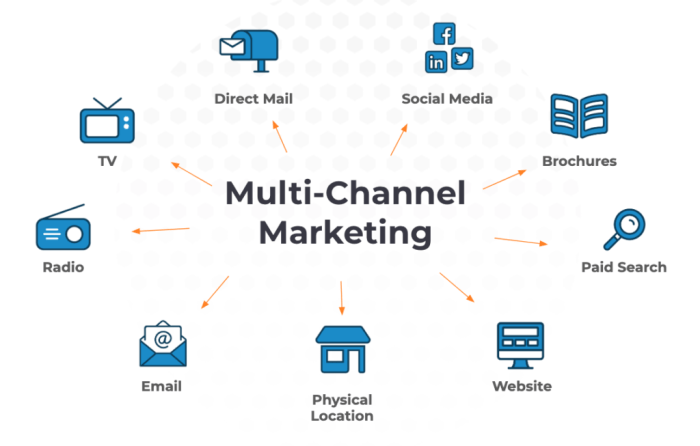Diving into Multi-Channel Marketing, where we explore the ins and outs of reaching your audience through various channels, like social media and email, to boost your brand’s visibility and engagement.
Unleash the power of multiple channels to connect with customers and enhance your marketing strategy.
Definition of Multi-Channel Marketing
Multi-channel marketing is a strategy that involves a brand or business interacting with customers through various channels both online and offline. This approach allows companies to reach their target audience through multiple touchpoints, providing a seamless and integrated experience across different platforms.
Examples of Different Channels in Multi-Channel Marketing
- Social Media: Platforms like Facebook, Instagram, and Twitter are used to engage with customers, share content, and drive traffic to the company’s website.
- Email: Sending personalized emails to subscribers for promotions, updates, and newsletters is an effective way to connect with customers.
- SMS: Text messaging can be used for quick communication, alerts, and exclusive offers to engage with customers on their mobile devices.
- Physical Stores: In-person interactions at brick-and-mortar locations provide a unique opportunity to showcase products and provide personalized service.
The Importance of Integrating Channels Seamlessly
Integrating these channels seamlessly is crucial for a cohesive marketing strategy as it ensures that the brand message is consistent across all platforms. By connecting the dots between different channels, businesses can create a unified customer experience and build brand loyalty. This integration also allows for better tracking of customer interactions and behavior, enabling companies to optimize their marketing efforts for maximum impact.
Benefits of Multi-Channel Marketing

When it comes to multi-channel marketing, the benefits are truly game-changing. By reaching customers through various channels, businesses can significantly boost their brand visibility and customer engagement. This strategy allows companies to connect with their target audience in different ways, making it easier to stay top of mind and drive more sales.
Increased Reach and Accessibility
- By utilizing multiple channels such as social media, email, and physical stores, businesses can reach a wider audience and make their products or services more accessible to customers.
- Expanding the reach can lead to increased brand awareness and attract new customers who may not have found the business through a single channel.
Improved Customer Engagement
- Engaging customers through different channels allows for more personalized interactions and tailored messaging based on their preferences and behaviors.
- Interacting with customers on various platforms creates a seamless and cohesive experience, enhancing brand loyalty and satisfaction.
Enhanced Customer Retention and ROI
- Multi-channel marketing can help businesses retain customers by staying connected and providing valuable content and offers across different touchpoints.
- Increasing customer retention rates ultimately leads to higher ROI as loyal customers are more likely to make repeat purchases and recommend the brand to others.
Strategies for Implementing Multi-Channel Marketing
Creating a consistent brand message across all channels is crucial for the success of a multi-channel marketing strategy. This ensures that customers receive a cohesive experience, no matter which platform they interact with.
Tips for Consistent Brand Message
- Develop brand guidelines: Establish clear brand guidelines that Artikel your brand voice, tone, and visual identity to maintain consistency across all channels.
- Use the same messaging: Ensure that your brand messaging remains consistent across all channels to avoid confusion and reinforce brand recognition.
- Monitor feedback: Regularly monitor customer feedback to identify any inconsistencies in messaging and make necessary adjustments.
Importance of Data Analytics
Data analytics plays a crucial role in optimizing multi-channel marketing campaigns by providing valuable insights into customer behavior, preferences, and interactions with your brand. By analyzing data from various channels, marketers can make informed decisions to improve campaign performance and ROI.
Examples of Successful Multi-Channel Marketing Campaigns
- Starbucks: Starbucks effectively utilizes multiple channels such as social media, email marketing, and mobile apps to engage customers and drive sales. Their consistency in branding and personalized customer experiences have made their campaigns highly effective.
- Nike: Nike’s multi-channel marketing approach integrates seamlessly across online and offline channels, providing a unified brand experience. Their use of data analytics to target specific customer segments has resulted in successful campaigns and increased customer loyalty.
- Amazon: Amazon’s multi-channel strategy combines e-commerce, mobile apps, and physical stores to create a seamless shopping experience for customers. Their data-driven approach allows for personalized recommendations and targeted marketing campaigns, leading to increased sales and customer satisfaction.
Challenges of Multi-Channel Marketing

Implementing multi-channel marketing strategies comes with its fair share of challenges that businesses need to address in order to maximize their impact. From channel conflicts to data integration issues, overcoming these obstacles is crucial for success in today’s competitive landscape.
Channel Conflicts
One of the most common challenges in multi-channel marketing is channel conflicts, where different channels within the marketing mix compete with each other rather than complementing each other. This can lead to confusion among customers and dilute the overall message of the brand.
- Establish clear guidelines and communication channels between different departments handling various channels.
- Ensure that each channel has a specific role and purpose in the overall marketing strategy to avoid overlap.
- Regularly monitor and analyze performance metrics to identify any conflicts and address them promptly.
Data Integration
Another major challenge is data integration, where businesses struggle to merge data from different channels into a cohesive and meaningful dataset. This can hinder the ability to track customer interactions across channels and provide a seamless experience.
- Invest in a robust CRM system that can centralize data from multiple sources and provide a holistic view of customer behavior.
- Implement data governance policies to ensure data accuracy, consistency, and security across all channels.
- Regularly audit data integration processes to identify gaps and streamline data flow for better insights.
Attribution
Attribution is another challenge in multi-channel marketing, as businesses struggle to accurately attribute conversions and sales to the right channels. Without proper attribution, it becomes difficult to measure the effectiveness of each channel and optimize marketing spend.
- Utilize multi-touch attribution models to assign credit to different touchpoints along the customer journey.
- Leverage marketing analytics tools to track and measure the impact of each channel on conversions and ROI.
- Experiment with A/B testing and control groups to understand the incremental value of each channel in driving conversions.





